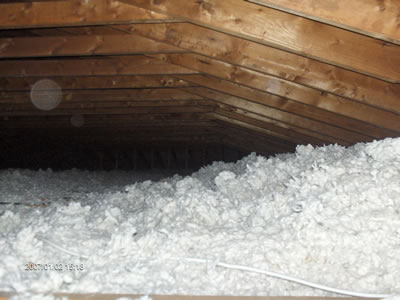Best Attic Insulation
|
So what’s the best attic insulation to use? It's certainly something we all need in our homes no matter what climate. If you live in the hot climate, you need it to keep the house cool. If you live in a cold climate, you need it to keep the house warm in the winter and cool in the summer. We all need adequate and well-installed attic insulation. |
Insulation will resist heat flow whether from below or above.
Basics Of Insulation
R-value is a term that you need to understand when you're talking insulation.
R-value means the thermal resistance.
It’s simple.
When you add more insulation, you add more R-value (more resistance of air transfer).
Each country, and even region will have different values for what the building code requirement is for R-value.
Here in Canada we require attic insulation of R-60 to meet building codes.
These requirements have been increased over the years to meet the challenge of saving energy in homes.
To obtain R-value: Multiply # of inches by factor.
Spray-Foam Insulation
Spray-foam insulation is a polyurethane foam insulation product. This insulation is sprayed into the attic with special equipment. This insulation is superior for filling all the cracks and voids. The only problem with this type of insulation is the added cost. However, the benefit of a well-sealed house is the benefit of this type of insulation. |
Fiberglass Batt Insulation
Fiberglass batt insulation is one of the most common types of attic insulation. It can easily be installed by the average homeowner. The payback in energy savings can be captured in 2 to 8 years. Fiberglass batt insulation is readily available at all home building centers. Of course, if you are looking to have a contractor install the insulation there are many companies that specialize in attic insulation installation. |
 |
Loose-Fill Fiberglass, Wool or Cellulose
Loose-fill attic insulation is also a commonly used insulation. This insulation must be blown into the attic with a special blower specifically designed for this type of installation. The contractor will determine how much loose-fill fiber needs to be added to get the required R-value. |
So What's The Best Attic Insulation?
That’s hard to answer.
If you’re looking for R-value (resistance) then your best bet would be an insulation that seals well such as loose fill or spray-foam.
But if you’re looking to install the insulation yourself, then the best is fiberglass insulation.
Ideally, cellulose loose-fill insulation is your best attic insulation for R-value.
When this loose-fill is blown into your attic, it creates a seamless coating of insulation throughout the attic.
With fiberglass batts, your contractor will need to ensure that the batts are laid in a criss-cross pattern.
This criss-crossing of batts avoids any open seams that would allow heat loss.
While your contractor is installing the batts, he has to ensure that the insulation is not compressed down during the installation. The insulation needs to remain light and fluffy.
All the insulations are designed as a fire retardant.
Make sure your contractor is using wood markers as depth gauges during installation. Make sure these markers are strewn throughout the attic to ensure uniformity. This will ensure the insulation is being strewn in a uniform level throughout.
The best attic insulation answer lies in what you are looking for.
Are you looking strictly for R-value?
Are you looking to install yourself?
Are you concerned about any voids or crevices losing warm air?
What can you afford? And what kind of payback can you expect?
Are you concerned about using an environmentally eco-friendly product?
The key is to ensure bringing your attic insulation to the minimum code requirements.
Here in Canada, I recommend nothing less than an R-value of 60 for attics. As most of our heat is lost through the attic, this is the place to invest the most insulation.
Return to Creative Home Remodeling from Best Attic Insulation
Return to Home Page at Remodeling Houses from Best Attic Insulation